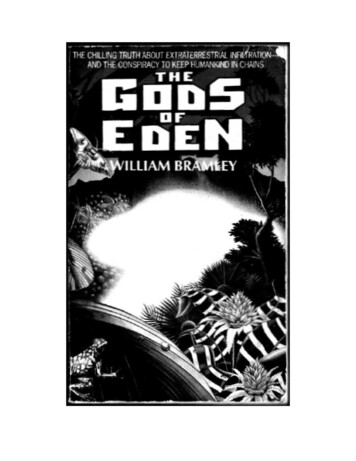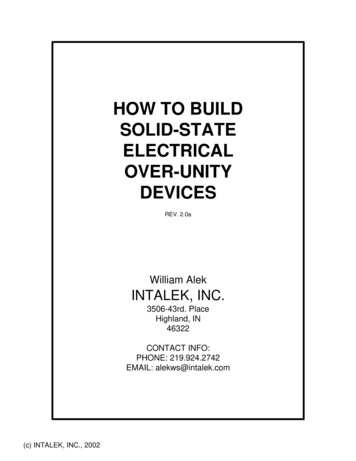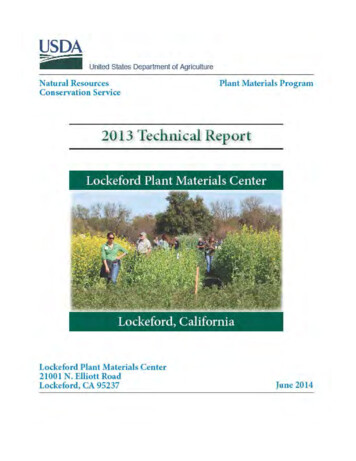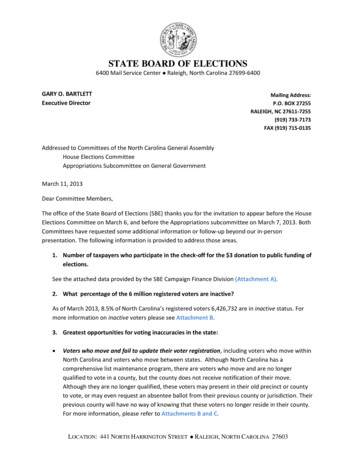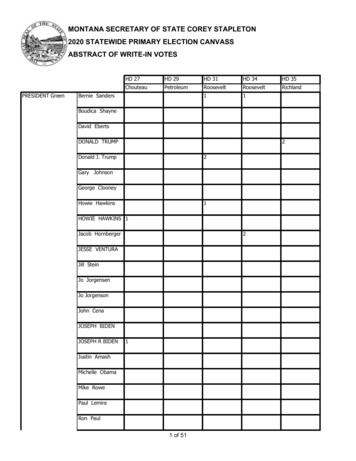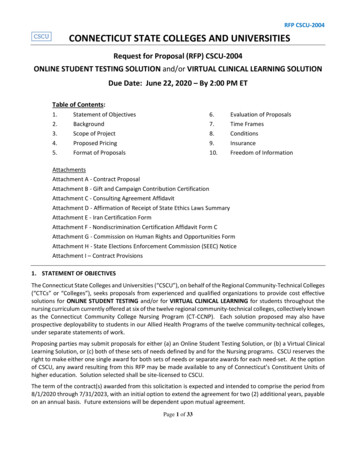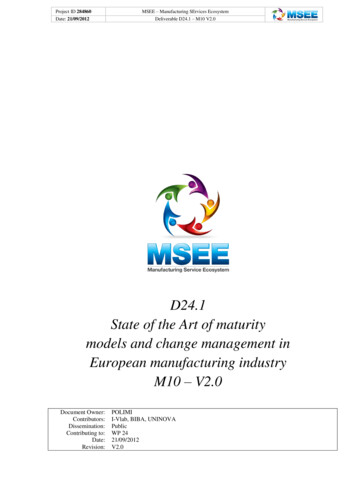
Transcription
Project ID 284860MSEE – Manufacturing SErvices EcosystemDate: 21/09/2012Deliverable D24.1 – M10 V2.0D24.1State of the Art of maturitymodels and change management inEuropean manufacturing industryM10 – V2.0Document Owner:Contributors:Dissemination:Contributing to:Date:Revision:POLIMII-Vlab, BIBA, UNINOVAPublicWP 2421/09/2012V2.0
Project ID 284860MSEE – Manufacturing SErvices EcosystemDate: 21/09/2012Deliverable D24.1 – M10 V2.0VERSION HISTORYDATENOTES AND COMMENTS0.114/05/2012LUCA FUMAGALLI (POLIMI) – INITIAL DELIVERABLEDEFINITION0.230/05/2012REVIEW AND INTEGRATION BY GUY DOUMEINGTS (I-VLAB),STEFAN WIESNER (BIBA), RICARCO GONCALVES (UNINOVA)0.304/07/2012LUCA FUMAGALLI (POLIMI) – INITIAL DELIVERABLE DRAFTVERSION0.409/07/2012REVIEW BY STEFAN WIESNER (BIBA)0.510/07/2012REVIEW BY LUCA FUMAGALLI AND DAVID OPRESNIK(POLIMI)0.612/07/2012PRESENTATION DURING MILANO MEETING0.712/07/2012REVIEW BY GUY DOUMEINGTS (I-VLAB)0.803/08/2012VERSION FOR REVISION BY PARTNERS0.927/08/2012REVIEW BY GUY DOUMEINEGTS (I-VLAB) AND STEFANWIESNER (BIBA)1.008/09/2012VERSION FOR PEER REVIEW – FINAL CHECK2.021/09/2012FINAL VERSIONDELIVERABLE PEER REVIEW SUMMARYIDCommentsAddressed ( )Answered (A)1Improve introduction in the Executive Summary 2Lack of a glossary 3Various improvements and corrections to the text MSEE ConsortiumDissemination: PU2/56
Project ID 284860MSEE – Manufacturing SErvices EcosystemDate: 21/09/2012Deliverable D24.1 – M10 V2.0Table of Content of D24.1IndexEXECUTIVE SUMMARY . 4GLOSSARY . 51. INTRODUCTION . 61.1 OBJECTIVE OF THE DELIVERABLE . 61.2 STRUCTURE OF THE DELIVERABLE . 62. DELIVERABLE SCOPE . 82.1THE DELIVERABLE IN THE SCOPE IN WP 24 OF MSEE PROJECT . 83. STATE OF THE ART OF MATURITY MODELS . 103.1 DEFINITION OF CONCEPTS - WHAT DOES THE SCIENTIFIC COMMUNITY MEAN FOR MATURITY ANDMATURITY MODELS? . 103.2 PURPOSE OF USE OF MATURITY ASSESSMENT - FOR WHAT MATURITY MODEL IS USEFUL FOR. 113.3 CLASSIFICATION OF MODELS AVAILABLE IN LITERATURE. 123.4 REVIEW OF MODELS AVAILABLE IN LITERATURE . 193.5 DISCUSSION . 374. STATE OF THE ART OF CHANGE MANAGEMENT ISSUES TO BE CONSIDERED . 394.1DEFINITION OF CONCEPTS - WHAT DOES THE SCIENTIFIC COMMUNITY MEAN FOR CHANGEMANAGEMENT? . 394.2PURPOSES OF CLASSIFICATION: TYPOLOGIES AND METHODS OF CHANGE MANAGEMENT . 404.3PURPOSE OF USE OF CHANGE MANAGEMENT CONCEPTS . 434.4INFLUENTIAL FACTORS IMPACTING CHANGE MANAGEMENT TECHNIQUES . 445. PRELIMINARY DEFINITION OF THE APPROACH FOR MATURITY ASSESSMENT ANDCHANGE MANAGEMENT FOR MSEE PROJECT . 506. CONCLUSIONS AND FURTHER STEPS . 517. REFERENCES . 53MSEE ConsortiumDissemination: PU3/56
Project ID 284860MSEE – Manufacturing SErvices EcosystemDate: 21/09/2012Deliverable D24.1 – M10 V2.0Executive SummaryAs defined for the scope of the project, this document provides description of the state of theart of maturity models and change management models and approaches, with particularreference to manufacturing industry, especially considering the need of Europeanmanufacturing industry to evolve towards services in order to keep competitiveness and bringinnovation into the market.The document presents a structured analysis, done through a survey of approaches aboutmaturity models and a literature analysis of change management issues and approaches.Objective and capabilities of such approaches are then highlighted.Main results presented in this deliverable are related with:--Comprehensive overview of the maturity models available in literature, with a specificfocus on maturity model to assess issues related with delivery and management ofservices.Overview of the change management approaches, showing a large range of possibleapproaches.First indication on maturity models and change management approaches within the MSEEscopeThe present deliverable is developed in the scope of WP24. In order to structure the analysisand provide useful information for the following research activity of WP24 and with theobjective to align the activity of the WP with the research activities ongoing in MSEE projectand specifically in SP1, maturity models and change management approaches are classifiedaccording to a modeling approach derived from the one provided in D11.1 of SP1 of MSEEproject.Synthesis of the models is provided, highlighting the direction for research development inthe scope of WP24. Results on this point is the presentation of different proposals comingfrom literature:-10 proposals from literature are presented and classified according to MSEE perspective.-CMMI based approaches for maturity assessment are deemed as the most interesting to beapplied for the next research in MSEE scopeFor what concern change management approaches the issues seems more differentiated andthe direction to be taken in the next activities of WP24 is not still provided by this document.Results on this point are:-Dissertation about concept of change management as discussed in the scientificcommunity-Presentation of main issues discussed in literature about change management-Outline of draft approach that, according to the literature highlighted in this deliverable,seems suitable for MSEE project and compliant for integrating a maturity assessmentmodel with a change management approach.MSEE ConsortiumDissemination: PU4/56
Project ID 284860MSEE – Manufacturing SErvices EcosystemDate: 21/09/2012Deliverable D24.1 – M10 V2.0GlossaryIn order to underline which are the main concepts discussed in this document some definitionsare here provided, giving quick literature background on the terminology used:MATURITY MODEL: “maturity” is the quality to be in a full development state.Maturity models, than, represent theories regarding organization capabilities and howthey evolve step by step along a foreseen, desired and logical path of growth(Gottshalk 2009, Kazanjian e Drazin 1989);MANUFACTURING SERVICE ECOSYSTEMS: specific type of networkedcollaborative organizations, demanding processes in which entities (organizationsand/or people) share information, resources and responsibilities to jointly plan,implement and evaluate a program of activities to achieve a common goal andtherefore jointly generate value. Although the existence of goal-oriented networks,Ecosystems are inserted in the category of Long-Term Networks, not dissolving afterthe achievement of a specific objective, but gradually developing capabilities andresources in order to activate networks every time they are requested.A Manufacturing Service Ecosystem, eventually, is a specific type of Ecosystemoriented to the creation of a non-hierarchical collaborative network in order todevelop an “extended” concept of product, under which, besides the physical productitself, associated services and knowledge become very important (Camarinha-Matoset al. 2009);CHANGE MANAGEMENT: change management is a structured approach to shiftingindividuals, teams and organizations from a current state to a desired future state. It isan organizational process aimed at helping employees to accept and embrace changesin their current business environment. A service change management, than,specifically embraces all the change management approaches allowing an OEMcompany to develop and move to a new business model in order to become part of amanufacturing service ecosystem;ROADMAPPING APPROACH: important and widespread methodology for aligningorganizational capabilities with organizational goals, thus helping in building acommon understanding across internal and external organizational capabilities. In thecontext of strategic planning, what roadmaps tend to have in common is the desire tocapture an high level, synthesized and integrated view of strategic plan/s in a simplegraphical or tabular format, as the focal point of a typical strategic planning documentor business case. While roadmaps can take various forms, they all seek to answer threemajor questions, considering a range of perspectives, including markets, products andtechnology: 1) Where are we going?; 2) Where are we now?; 3) How can we getthere? (Phaal et al., 2004).The scope of these project, indeed, is developing a change management approach inorder to enact the roadmaps emerged from the analysis of maturity of severalcompanies willing to create Manufacturing Service Ecosystems.MSEE ConsortiumDissemination: PU5/56
Project ID 284860MSEE – Manufacturing SErvices EcosystemDate: 21/09/2012Deliverable D24.1 – M10 V2.01.Introduction1.1 Objective of the deliverableThe objective of the present document is to discuss:- the approaches for the assessment of maturity and- methods to guide change managementThis discussion allows the definition of possible roadmap for evolution towards servitizationand towards a prosperous collaboration in ecosystems.MSEE project will provide a platform but beside this supporting tool, company must beguided across the evolution aforementioned.Support is needed in order to allow companies following a roadmap that include in a sparseway organizational, strategic, operational, technological issues. Nevertheless these spareconcepts must be ordered in such a way that allows scientific approach to the evolution.Two steps are needed:First step is the definition of a scientific metric for maturity, allowing to analysepractices of the companies for servitization and collaboration in ecosystems.Second step is the definition of a change management approach, namely a way todefine a roadmap and make the company able to follow it.This deliverable discusses the literature related with these scopes of research. Analysis ofliterature is a preliminary research activity that will allow the further steps needed for MSEEproject.1.2 Structure of the deliverableThe deliverable is structured in the following way. After this introduction of the objective ofthe document scope covered by the research presented in the deliverable is highlighted, withspecific concern to MSEE project.Then, from section 3 the state of the art analysis is reported, starting from discussion aboutmaturity models. The approach considered is literature analysis. Reference analysed are listedand some hints of each reference are provided into a summarizing table.Then, still in section 3, 10 maturity models, namely proposals from the scientific communityare presented. These 10 proposals are analysed according to two classification ways. Oneconsiders the application domain of the model, considering a classification approachcompliant with the research carried out in SP1 of MSEE project. A second classificationhighlights specific features of the models (simplicity, objectivity, flexibility, adaptability (to aquestionnaire), capability).Section 4 is then dedicated to discuss the other main topic analysed in this deliverable: changemanagement. Change management approaches are not so structured that can be classified as alist of models. Thus, firstly an overall discussion about change management issues, analyzingMSEE ConsortiumDissemination: PU6/56
Project ID 284860MSEE – Manufacturing SErvices EcosystemDate: 21/09/2012Deliverable D24.1 – M10 V2.0available literature is reported. Then, main relevant aspects discussed in literature arediscussed in the second paragraph of section 4. No specific classification of the approaches isprovided, being the section structured as a discussion to provide literature background on thetopic. Section 5 provides then the conclusions of the deliverable highlighting which are themain useful results coming from the analysis for the MSEE project and listing next researchactions envisioned in the project on the topics discussed in this document.MSEE ConsortiumDissemination: PU7/56
Project ID 284860MSEE – Manufacturing SErvices EcosystemDate: 21/09/2012Deliverable D24.1 – M10 V2.02.Deliverable scope2.1 The deliverable in the scope in WP 24 of MSEE projectThe main aim of WP24, as described in the DOW of MSEE project, is the description of aState of the Art of maturity models and change management, especially the investigation ofavailable approaches and election of appropriate Maturity Models in manufacturing ServiceEcosystems, the analysis and evaluation Service-oriented change management for differentactors in the Ecosystem.WP24 mainly consists of three tasks. The following is a short description of the tasks; T24.1and T24.2 are briefly described, because they are the ones more related with the presentdeliverable.-T24.1 Description of a State of the Art of maturity models and change managementThe first task, led by POLIMI in cooperation with BIBA, I-VLAB,UNINOVA, deals with state of the art analysis. As stated in the DOW, in thescope of T24.1 a survey of approaches about maturity models and changemanagement is conducted. In a second step of the task linkage betweenmaturity models and change management will be created. Finally a genericmodel framework to be used in MSEE will be proposed.-T2.4.2: Analysis of requirements and challenges of Service-oriented changemanagement for actors in an ecosystemThe second task, led by POLIMI in cooperation with BIBA, I-VLAB,UNINOVA, focuses more on the change management with respect to differentactors that can operate in an ecosystem. The main types of players ofmanufacturing ecosystems will be analyzed in order to understand better theirchange management requirements and challenges. Based on this, a serviceoriented change management approach will be developed.-T2.4.3: Specification and Development of a generic change management approach toanalyze manufacturing service ecosystemsThis document (D24.1) is mainly related with the above mentioned T24.1 and T24.2; the twomain objectives of the present document are:To agree on what Maturity assessment and Change management mean within MSEETo analyze suitable formalism/approach to address the assessment of Maturity and themanagement of change for service innovation.This deliverable reviews the literature approaches, then, as a follow up in other researchactivities in MSEE project, a selected approach will be used and tailored to identify maturityof a company/VE in the servitization process and in its interaction with the ecosystems (thisMSEE ConsortiumDissemination: PU8/56
Project ID 284860MSEE – Manufacturing SErvices EcosystemDate: 21/09/2012Deliverable D24.1 – M10 V2.0allows to position the company product-service process in a two axis space). Maturity willrepresent a third dimension, namely, being a company positioned in a certain point of thatspace, maturity model will allow to score the level of maturity with respect to that point. Insection 5 of this deliverable a figure is also proposed to explain the envisioned space ofanalysis.To this end, information to complete this research vision will come from: WP25 for whatconcerns Ecosystems axis, WP21 for what concern Servitization axis.Beside this assessment made on a specific “point” in the space of analysis, a trajectory can bealso defined. The “point” is the focus of the maturity assessment. It considers a singlecompany or, equivalently for the analysis presented in this deliverable, a virtual enterprise.The aim is to analyse an actor that makes a business related with services or not yet relatedwith services and that intends to evolve in the servitization process. As mentioned, it is notimportant that this actor is a formal single company, but it can be also a group of company,anyway acting as a single business unit, thus representing a virtual enterprise.However, we take also into account that not isolated enterprises are under concern, butEcosystems are considered. Tailored approaches must be kept when dealing with Ecosystems.Indeed the objective is to assess the maturity of such actor collocated in a certain position inthe above defined space.The trajectory, that the point follows, defines paths of the evolution that are roadmaps that canbe followed according to the specific strategic needs of the companies. Such roadmaps areenvisioned to be considered for the evolution of the cases that will be analysed in the scope ofMSEE project (Indesit, Bivolino, Philips, Ibarmia). This envisioned research activity is in thescope of WP24 and the present deliverable represent the first document released by WP24,namely the first brick for this research.Such research activity will allow also to develop a change management approach to be thenused as support beside the availability of MSEE platform.MSEE ConsortiumDissemination: PU9/56
Project ID 284860MSEE – Manufacturing SErvices EcosystemDate: 21/09/2012Deliverable D24.1 – M10 V2.03.State of the art of maturity models3.1 Definition of concepts - What does the scientific community mean formaturity and maturity models?Maturity is literally defined as "the quality of being in a state of full development".Under the assumption of predictable patterns, maturity models are theories on how theorganizational capabilities evolve step by step, through a planned, desired or logicalmaturation (Gottshalk 2009, Kazanjian and Drazin 1989). This is the reason why thematurity models are also referred to models of the growth stage (see Prananto 2003). Thefirst examples of maturity models include a hierarchy of human needs (Maslow 1954),economic growth (Kuznets 1965), and the progression of information technology inorganizations (Nolan 1973). Nolan’s stage model was considered useful and used byacademics and professionals, and led to the birth of many maturity models based on asequence of levels (Solli - Gottshalk and Saether 2010).An example of application of a maturity model can be seen in Deloitte, company which hascreated an application management maturity model as a structured framework foridentifying and evaluating opportunities for improvement in application management. Anapplication management environment comprises of seven capability areas: strategy,organization, financials, talent, processes, technology and service delivery. Using theapplication management maturity model, Deloitte assessed four focus areas within eachcapability area, thus producing a final report which illustrated the maturity of each focusarea and identified gaps (Deloitte, 2009).Since their birth, maturity models have been criticized. First, they were defined as a sort of"step by step" procedure for development, which oversimplify the empirical reality, butthat somehow can explain in few words what they are.Benbasat (1984), whose studies are mainly oriented on the IS field, casts doubts on one ofthe basic guidelines of the stage-model, which is that the characteristics of each stageshould be distinct and empirically testable. The empirical studies surveyed by Benbasat, onthe other hand, state that various maturity criteria do not reliably move together, or evenalways in the same direction, thus refuting one of the requirements for claiming theexistence of a stage theory. Benbasat, anyway, recognizes the potential of the stage model,whose major supporters affirm that maturity is not a static concept, and whose problemscan surely be attributed to the fact that it was based on personal experiences in a very smallnumber of organizations at what it has to be considered as an early point in thedevelopment of the IS field.King and Kraemer (1984), similarly, affirm that the empirical bases of the stage-model arequestionable, and some evidence is available that they are factually mistaken. The stagemodel, related to the growth of computing in organizations, has had a powerful influenceon the information systems field; its popularity is probably due to its bold approach todealing with an highly complex phenomenon in a straightforward and clever manner. TheMSEE ConsortiumDissemination: PU10/56
Project ID 284860MSEE – Manufacturing SErvices EcosystemDate: 21/09/2012Deliverable D24.1 – M10 V2.0model, even if the first treating of this topic in such a structured scheme, and recognized insome parts by practitioners and researchers, is incomplete in its attempt to capture thelarger organizational context within which computing occurs, and it is not accurate in theaccounting of the relationships between the various components in the context. However,the two authors recognize that the model makes two significant contributions: first, itmakes explicit the notion that the growth must be due to the influence of forces both insideand outside the organization, even if it doesn’t give clues regarding their interplay andinteractions while shaping computing; second, it introduces an intellectual powerfulconstruct of dialecticalInterplay between freedom and constraint in the control of computing that yields periodicstates of equilibrium. The stage-model, in some way, has therefore provided interestingand testable hypotheses for researchers to explore.De Bruin and other authors, by the way, underline that the value in a generic methodologylies, rather than in a specific stage-model, in the ability to develop a model which ischaracterized by an high generalisability and standardization. Use of a standardmethodology enables a state of model development to be reached and for incrementalimprovements to be made over time. The value to organizations of applying such a modelresides in the ability to measure and assess domain capabilities at a certain point in time,thus achieving sustainability (De Bruin et al., 2005).In addition, the maturity models tend to neglect the possible existence of multiple paths(for evolution) equally good (Teo and King 1997).Regardless of application domains, most maturity models refer to multiple entity classes.According to Mettler and Rohner (2009), typical classes are the people, processes, or otherobjects from a specific application domain. Kohlegger (2009) distinguishes betweenobjects, people and social systems. Another distinction relies on the resource based view ofthe firm (Wade and Hulland 2004), where the resources are classified into assets andcapabilities.According to Mettler and Rohner (2009), maturity models should be configurable as theirinternal and external characteristics may limit the applicability of the model in its standardversion (Iversen et al. 1999). King and Kraemer (1984) suggest that maturity modelsshould not focus on a sequence of levels toward a final state by default, but the factors thatdetermine the evolution and change. Further criticisms relate to the multitude of maturitymodels are similar to the ones mentioned. Also the lack of satisfactory documentation ofthe design process is often mentioned (Becker et al., 2009, Becker et al. 2010, Iversen et al.1999).3.2 Purpose of use of Maturity assessment - For what maturity model is usefulforThe maturity models that represent the theories of evolution "step by step", are meant todescribe the basic steps and pathways of maturation. Consequently, it should be explainedthe characteristics of each phase and the logical relationship between the phases(evolutionary path).MSEE ConsortiumDissemination: PU11/56
Project ID 284860MSEE – Manufacturing SErvices EcosystemDate: 21/09/2012Deliverable D24.1 – M10 V2.0As for their practical application, maturity models are required to state the level ofmaturity, current and desirable, including their measures for improvement.The objective is to diagnose and eliminate the deficiency of capacity (Rummler and Brache1990). In general, three specific objectives can be distinguished (Becker et al. 2009, deBruin et al. 2005, Iversen et al. 1999, Maier et al. 2009): Descriptive: a maturity model has a descriptive purpose when it is applied to theassessments as-is, where entities' ability under current observation are evaluated againstcertain criteria (Becker et al. 2009). The maturity model is used as a diagnostic tool(Maier et al. 2009). The maturity levels assigned are reported to internal and externalstakeholders. Prescriptive: a maturity model has a prescriptive purpose when it allows identifyingdesirable levels of maturity and provides guidance on improvement measures (Becker etal. 2009). Comparative: a maturity model presents a comparative view when adopted to allow acomparative analysis (benchmarking) internal or external. Through analysis of historicaldata, the maturity levels of the business units and / or similar organizations can becompared with each other (de Bruin et al., 2005, Maier et al. 2009).In the context of MSEE project, therefore, maturity models are tools that help assessing “thequality of a company, or virtual enterprise, of being in a condition for which it is able tocreate an extended product, in case through the deployment of interactions it has developed ina collaborative network (i.e. ecosystem) with other companies”. In this way, maturity modelsallow to consequently build roadmaps and linked change management procedures whichshould be enacted by companies willing to stay in the present condition with a better qualityor to move towards a new one. These themes will be treated with more details in the nextsections of this deliverable.3.3 Classification of models available in literatureIn this section literature analysis of methods, approaches and models related with maturityconcept are analysed.Main models referenced in literature have been revised and are the ones included in thefollowing references (see next table). To give a quick feedback on the topics addressed byeach scientific work, it is indicated when the reference specifically addresses specifically thefollowing topics of interest for the analysis:-Type of the maturity model treated in the reference;-CMMI-based maturity model, with consequential use of a CMMI/maturity levelsapproach for the maturity assessment (the following sections of this deliverable willthen provide further explanation detailing what CMMI approach is);MSEE ConsortiumDissemination: PU12/56
Project ID 284860MSEE – Manufacturing SErvices EcosystemDate: 21/09/2012Deliverable D24.1 – M10 V2.0-Work on a maturity model which is just a compound of researches and studiesconducted by experts, but can be considered as pure research, not tested withcompanies;-Work on a maturity model which, together with a progressive research, isaccompanied by some applications to real case studies, thus revealing practicalapplicability.Reference12345678Type of MM (ifpresent):Aberdeen Group 2007. The PACEframework in report Aberdeen.Abideen Tetlay , Philip John 2009.“Capability Readiness for ProductService Systems.” 7th InternationalConferenceonManufacturingResearch (ICMR09) University ofWarwick (UK), September 8th – 10th2009.Babak Sohrabi, Mohammad Haghighi,Amir Khanlari (2010). “Customerrelationship management maturitymodel (CRM3): A model for stepwiseimplementation”. International journalof human sciences. Volume 7 issue 1.Becker, J., Knackstedt, R. andPöppelbuß, J. (2009). DevelopingMaturity Models for IT Management –A Procedure Model and itsApplication. Business & InformationSystems Engineering (BISE), 1 (3),pp. 213-222.Becker, J., Niehaves, B., Pöppelbuß, J.and Simons, A. (2010). MaturityModels in IS Research. In Proceedingsof the European Conference onInformation Systems (ECIS), PretoriaManaging Service Quality 15 (2), pp.142-155.Benbasat, I., Dexter, A. S., Drury, D.H. and Goldstein, R. C. (1984). Acritique of the stage hypothesis: theoryandempiricalevidence.Communications of the ACM, 27 (5),pp. 476-485.Burgeretal.2010. Servicedevelopment for product services: amaturity model and a field research,European Association for Research onServices(RESERConference),January 2nd 2011, Hamburg.De Bruin, T., Rosemann, M., Freeze,R. and Kulkarni, U. (2005).MSEE ConsortiumCMMIbasedPureresearch:Applied tocase studies:PACE framework CR CRM3 ITSM Nolan’s stage-modelDissemination: PU NSD CMM 13/56
Project ID 284860MSEE – Manufacturing SErvices EcosystemDate: 21/09/2012Deliverable D24.1 – M10 V2.0910111213141516Understanding the main phases ofdeveloping a maturity assessmentmodel. In Proceedings of theAustralasianConferenceonInformation Systems (ACIS), Sydney.Gottschalk, P. (2009). Maturity levelsforinteroperabilityindigitalgovernment. Government InformationQuarterly, 26 (1), pp. 75-81.InnoScoreServiceEvaluatinginnovation for product-related services2011 Annual SRII Global ConferenceMike Freitag Service Devel
State of the Art of maturity models and change management, especially the investigation of available approaches and election of appropriate Maturity Models in manufacturing Service Ecosystems, the analysis and evaluation Service-oriented change management for different acto
